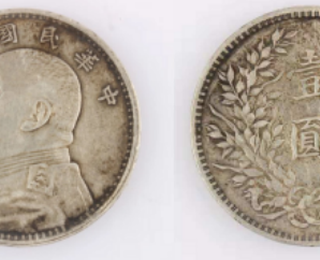新加坡拍卖民国三年袁大头壹圆
- ¥100.00 ≥ 1枚
- 2018-10-22 15:35:48
- 展览拍卖
- 纸盒包装
- 钱币交易,钱币拍卖,新加坡拍卖,钱币鉴定
- 占小燕 15915387591
- 深圳弘博艺术品展览有限公司
信息介绍
详细参数
此枚民国三年袁大头壹圆为藏友,品相保存精美。袁大头是1912年2月13日袁世凯就任民国监时大,后为大,他为了巩固事业,统一钱币铸造了以他头像的银元,这枚银币的版本是大胡须版,在民国三年中的银币大胡须版为稀用版,然而这枚钱币是稀有中的币,一般大胡须版的胡须是贴平在鼻孔之下的。恬恬这枚钱币的胡须以cuo版的形成,它的胡须与鼻尖齐象一颗寿桃一样立在鼻尖下,此枚钱币重26.6g直径3.88cm,从含银的成色与比重来看,它含银在90%之间,从自然风化与包浆皮壳分晰,它是一枚真正到代的“袁大头”大胡须珍贵cuo版币,十分少见 ,其后南京、广东、武昌、甘肃等地的造币分厂陆续铸造,由于其银两分量足、信誉好,成为民国时期乃至往后更长时间中国各地大量使用的通行货币。而袁大头分为民国三年、八年、九年、十年版等,其中民国三年大胡须版的有市场价值而且品相精美,具有很高的收藏投资价值。
In the three years of the Republic of China, Yuan Datou's one circle was handed down to Tibetan friends, and the products were kept beautifully. Yuan Datou was president of the Republic of China on February 13, 1912, when Yuan Shikai became governor of the Republic of China, and then president of the Republic of China. The beard of a large bearded version is pasted under the nostrils. The beard of this coin, Tiantian, stands at the tip of the nose like a longevity peach. The coin weighs 26.4 g and is 3.88 cm in diameter. It contains 90% silver in color and proportion. It is distinguished from natural weathering and envelope shell. It is a real "Yuan Datou" beard from generation to generation. Since then, the coinage factories in Nanjing, Guangdong, Wuchang, Gansu and other places have minted coins. Because of their two-component silver and good reputation, they have become the currency widely used in China during the Republic of China and even for a long time to come. Yuan Datou is divided into three years, eight years, nine years, ten years of the Republic of China edition, of which the three years of the Republic of China beard edition of the most market value and exquisite, has a high collection and investment value.
名称:民国三年袁大头壹圆
款识:民国
规格:重26.8g 直径3.88cm
类别:杂项
而袁大头是民国时期主要流通货币之一,袁大头 是对袁世凯像系列硬币的口语俗称,严谨点说叫 袁世凯像背嘉禾银币。北洋zheng府为了整顿币制,划一银币,于民国三年(1914年)二月,颁布《国币条例》十三条,决定实行银本位制度。《国币条例》规定:以库平纯银六钱四分八厘为价格之单位,定名为圆,一圆银币,总重七钱二分,银八九,铜一一","一圆银币用数无限制",即以一圆银币为无限法偿的本位贷币。根据这一规定,于1914年12月及1915年2月, 先后由造币总厂及江南造币厂开铸一圆银币,币面镌刻袁世凯头像,俗称"袁头币"或"袁大头"。“袁大头”在货币收藏界被称为银元之宝,它是中国近千种近代银币中流传广、影响大的银元品种,也是近代中国币制变革中的一个重要角色。民国三年的袁大头具有的投资收藏价值。
Yuan Datou was one of the main circulating currencies in the period of the Republic of China. Yuan Datou was a colloquial term for a series of coins of Yuan Shikai's portrait. It was called Yuan Shikai's portrait carrying Jiahe silver coin. In order to rectify the monetary system, the Beiyang government, in February of 1914, promulgated Article 13 of the National Monetary Regulations, and decided to implement the silver standard system. The National Monetary Ordinance stipulates that a unit of 6.4 cents and 8 cents Sterling Silver in the Treasury shall be designated as a round, a round silver coin with a total weight of 7.2 cents, silver 89, copper 11 "and a dollar of silver coin with unlimited usage", i.e. a dollar of silver coin shall be the standard currency for indefinite repayment. According to this regulation, in December 1914 and February 1915, a round silver coin was minted by the Mint General and Jiangnan Mint, and the coin was engraved with the head of Yuan Shikai, commonly known as "Yuan Tou coin" or "Yuan Datou". "Yuan Datou" is known as the treasure of silver dollar in the monetary collection circle. It is the most popular and influential silver dollar variety among the nearly one thousand kinds of modern silver coins in China, and it is also an important role in the monetary reform of modern China. Yuan Datou in the three years of the Republic of China has very high investment and collection value.
- 钱币交易,钱币拍卖,新加坡拍卖,钱币鉴定
- 历代银币
- 占小燕
- 展览拍卖
- 纸盒包装
- 金属
- 纪念品收藏品
钱币信息
-
 新梨七号梨树苗栽培技术梨树价格¥ 6
新梨七号梨树苗栽培技术梨树价格¥ 6 -
 重庆酸辣粉加盟哪家好特色麻辣粉砂锅培训班面议
重庆酸辣粉加盟哪家好特色麻辣粉砂锅培训班面议 -
 湖南启闭机,闸门价格低廉面议
湖南启闭机,闸门价格低廉面议 -
 新疆吐鲁番螺旋手扶抛雪机高效率多用除雪机平稳启动¥ 4800
新疆吐鲁番螺旋手扶抛雪机高效率多用除雪机平稳启动¥ 4800 -
 麻辣烫加盟面议
麻辣烫加盟面议 -
 河北唐山工业用水活性炭处理煤质颗粒活性炭厂家直销¥ 4300
河北唐山工业用水活性炭处理煤质颗粒活性炭厂家直销¥ 4300









